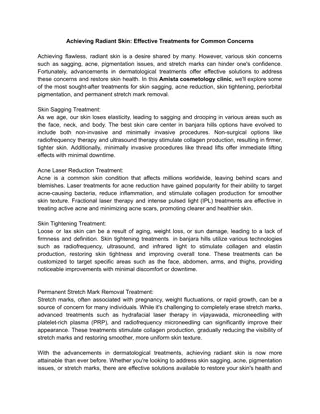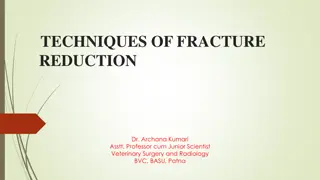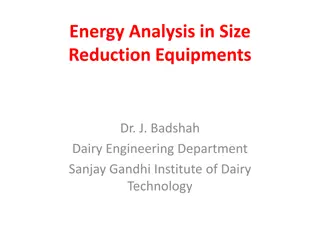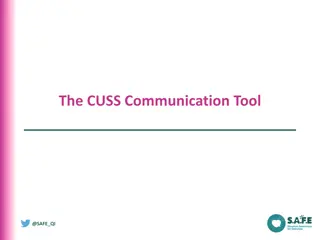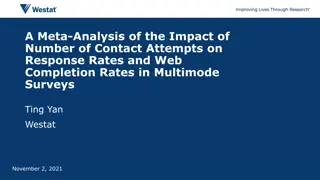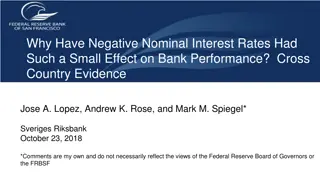Addressing Concerns Regarding Reduction of Policyholder Bonus Rates
The Appointed Actuary recommended a reduction in policyholder bonus rates for a big life insurance company with significant participating business. An Independent Director expressed dissatisfaction over the reduction compared to previous years and urged the Actuary to at least maintain last year's rates. The Actuary must justify the recommendations, considering regulatory and professional aspects, in responding to the Director's concerns to be presented at the upcoming board meeting.
Download Presentation

Please find below an Image/Link to download the presentation.
The content on the website is provided AS IS for your information and personal use only. It may not be sold, licensed, or shared on other websites without obtaining consent from the author.If you encounter any issues during the download, it is possible that the publisher has removed the file from their server.
You are allowed to download the files provided on this website for personal or commercial use, subject to the condition that they are used lawfully. All files are the property of their respective owners.
The content on the website is provided AS IS for your information and personal use only. It may not be sold, licensed, or shared on other websites without obtaining consent from the author.
E N D
Presentation Transcript
38th India Fellowship Seminar Date: 12th - 13th January 2023 Life Case Study Bonus Reduction for Participating Business Guide : Navin Iyer Presented By : 1. Nigel Lobo 2. Vidhi Aggarwal 3. Smruti S Abhyankar
Case Study You have recently taken charge as Appointed Actuary of a big life insurance company with significant portfolio of participating business. You have sent your recommendation for reduction of policyholder bonus rates which will be presented in the upcoming board meeting of directors. An Independent Director of the company, who received board meeting papers as a pre-read, has written a mail to you expressing dissatisfaction over the reduction of bonus rates recommended by you. The rates have come down compared to last year. While the interest rates have come down in the past 3 years, there was no reduction in interest rates, this year. The Independent Director mentioned in his mail that your predecessor was policyholder friendly and always tried to maintain high bonus rates whereas you, according to him, did not seem to bother much about policyholders. He suggested you to at least maintain the last year bonus rates. He also mentioned in his mail that he would recommend the same to the board even if you decide to stick to your current recommendation. Draft a suitable reply to the Independent Director addressing all his concerns and justifying your bonus recommendations. Please evaluate various options and possibilities, and keep in mind relevant regulatory and professional aspects while drafting your reply. www.actuariesindia.org
About the guide Navin Vishwanath Iyer is a Consulting Actuary and Founder of Prime Actuarial Solutions. He is also a qualified Chartered Accountant. With close to 2 decades of experience in the actuarial space spanning across both Insurance and Employee Benefits, he brings diverse experience across multiple markets viz., India (including the sub-continent), Middle East, US, UK and Australia. The firm is engaged in multiple assignments ranging from reserve and solvency certifications, reporting, IFRS17 consulting, product development and pricing, peer-review, with profits actuarial work etc. The firm supports several companies in India and overseas. Navin is currently the Consulting Actuary for Postal Life Insurance (PLI) that manages an AUM close to INR 130,000 crores. He is responsible for all aspects of actuarial work for this entity. He has been engaged as a With-profits Actuary and Peer Reviewer for several leading insurers in the Indian market for past few years. He is also working as a Certifying Actuary for a leading Life Reinsurer. He also serves as a Consulting Appointed Actuary to several Companies outside India. Navin worked with several leading Insurers (PNB MetLife, Kotak Life, Canara HSBC Life) in leadership roles before starting his practice 6 years ago. www.actuariesindia.org
Executive Summary The Appointed Actuary has decided to reduce bonus rates, but the Independent Director has strongly objected to the same. Company has a defined methodology for setting bonus rates, as defined in the bonus philosophy document and has been reviewed and approved by the WPC and the Board. This is consistently followed every year. Future bonuses are never guaranteed however, the past declared bonuses shall be guaranteed The company s bonus setting procedure has indicated that the previous year s reversionary bonus rates are not sustainable. The nature of guarantee in the With-profits business lies between non-par and unit linked business www.actuariesindia.org
Process of Setting Bonus Rates 1. Bonus Earning Capacity (including Asset Shares) 2. Policyholder s Reasonable Expectations (PRE) 3. Sustainability of Bonus declaration www.actuariesindia.org
Bonus Earning Capacity There are two commonly used methods to calculate Reversionary bonus: Equating the Asset Share on Valuation date with the best estimate liability (BEL) at the Valuation Date Project the Asset Share using actual experience till valuation date and best estimate assumptions from valuation date to maturity, and thereafter comparing it with maturity value The ratio of maturity benefits to asset share is targeted to be in the range of 95%-105% IRDAI (Non-Linked Insurance Products) Regulations and Guidance Note 6 also mandates this method of calculation of bonus rates. Asset Share is defined as the accumulation of the premiums plus investment income less deductions such as policyholder benefits, expenses, commissions and other outgoes Asset Share is the benchmark for fairness in the policyholder pay-outs and is consistent across the market. The asset share at maturity may still be higher than the sum assured on maturity and the declared reversionary bonuses. This excess asset share is paid to the policyholder through terminal bonus. The bonuses are set at the product level and the fairness of the same is ensured at the cohort level. www.actuariesindia.org
Policyholders Reasonable Expectations (PRE) The policyholder expects that the company will conduct business and declare bonus rates in a fair manner. There is also an expectation that there is a defined methodology underlying the calculation of bonus rates and there are no arbitrary changes in the bonus rates year on year. PRE can be formed from the following sources : Marketing Documents such as Policy Literature and Benefit Illustration Advertisements and Communications to Policyholders Past Practice of our Company Practices adopted our Competitors After arriving at the bonus rates using technical analysis mentioned above, IRR analysis for policy holders is done to ensure that the pay-outs are fair and reasonable The requirements for PRE are laid out in the APS1 and GN6 www.actuariesindia.org
Other Considerations with Setting Bonus Rates Sustainability of Bonus declaration The interest rates have fallen over the past three years. Even though the interest rates have not fallen this year, there are expectations that the interest rates are on the downward trajectory. The past declared RB is guaranteed and needs to be paid irrespective of the future investment performance The asset share must be projected using realistic investment rates while setting future bonus rates. Besides, the FFA/Estate should not be used for supporting reversionary bonus declaration year on year Therefore, consideration needs to be given to the strength of the estate while setting the bonus rates. Lastly, all requirements as spelt out in IRDAI (Non-Linked Product) Regulations 2019 for WPC have been met www.actuariesindia.org
Assumptions The company writes both par and non-par business The company has been operating par business for many years and has a bonus philosophy in place which is reviewed by the WPC from time to time. We are expecting a decreasing interest rate scenario in the country. We currently have not made any Forward Rate Agreements. This exposes our company to significant reinvestment risk. Withdrawal surplus doesn t flow in the Asset Share The Independent Director is not a part of WPC The Independent Actuary in the WPC and the Appointed Actuary are on the same page Bonus rates have not been dropped for at least three years www.actuariesindia.org
Reasons for Drop in Bonus 1. Investment Performance 2. Expenses 3. Withdrawals 4. Mortality 5. Tax 6. Other reasons www.actuariesindia.org
Investment Return The interest rates have been reducing for the past three years. As a result of the above, there is an expectation that there will be a decrease in the interest rates in future as well. Due to this, the asset share at maturity is not expected to be high enough to meet the reversionary bonuses at the current level. There is a potential increase in the cost of guarantees due to the drop in the interest rates for the past three years, decelerating the growth of the overall Asset Share of the business; therefore, the bonus rates are cut. If the investment return scenario changes, we will pass on the excess asset share through terminal bonus. www.actuariesindia.org
Depletion of Estate This fund gets created and represents the accumulation of past undistributed profits. One of the main purposes of this fund is to smoothen the bonus pay-outs for the policyholders. However, to maintain the bonus rates for the past few years, the estate might have been depleted. Thus, the previous years bonus rate can no longer be sustained. The company might be continuing to face expense over-runs which will impact the estate. Besides, due to increase in withdrawals (not offset by new business), the per policy expense might have increased. The methodology of the split of indirect expenses between the par and non-par business might have been changed leading to higher allocation of expenses for the par business. The change in the calculation methodology for the Surrender Value might lead to increase in the cost to the estate. The actual withdrawals might be lower than expected which reduces the surplus expected to be transferred to the estate. This will reduce the estate. www.actuariesindia.org
Mortality and Taxes Mortality The A/E claim ratio (on the priced basis) may be higher than expected. Therefore, the company may have increased their mortality assumptions while projecting asset shares. This would have reduced the bonuses which could be distributed to the policyholders. Taxes As the par business is profitable, tax has been deducted from the Asset Share taking into account the regulatory filing, sales literature and other disclosures. There can be a change in the Methodology of taxation in the calculation of Asset Share leading to a change in the bonus rate. www.actuariesindia.org
Other Reasons The reduction in the bonus rates might have been deferred for a long time and is being implemented now. There might be a change in the asset mix of the company leading to lower investment return Credit defaults by various banks/institutions might lead to loss on the expected investment income. Sensitivity analysis and Business plan forecasting on sustainability showed bonus rates had to be cut There was an operational error in the calculation of bonus rates earlier which led to the drop in the bonus rates now. www.actuariesindia.org
Response to the Independent Director 1. Policyholder Friendliness 2. Stable interest rate vs. Reduced bonuses 3. Proposal 4. Options Considered www.actuariesindia.org
Policyholder Friendliness Policyholder-friendliness not reflected by high bonus rates Protection of policyholders benefits and interests, including meeting policyholder obligations in a timely manner Fair and equitable treatment to current as well as future generations of with-profits policyholders Consistency between asset shares and final payouts Discretionary nature of bonuses Bonuses not guaranteed and depend on future performance Policyholders informed through benefit illustrations as per regulatory requirements on benefit illustrations and market conduct aspects www.actuariesindia.org
Stable interest rate vs. Reduced bonuses May be a temporary economic scenario Stable in current year Interest rates reduced over past 3 years And hence not indicative enough that interest rates will not be reduced in future years Fall in running yield on par fund (not sufficiently offset by other asset classes comprising the fund) leading to drop in the long-term expectation of best estimate interest rates Interest rates not the only factor affecting bonus rates Other experience items such as expenses, withdrawals, mortality also affect the bonus rates directly or indirectly www.actuariesindia.org
Stable interest rate vs. Reduced bonuses contd. Company maintained same bonus rates despite falling interest rates in the past however, this is no longer sustainable Maintaining bonus rates at previous year s level will make current generation of with policyholders happy Cutting the bonus rates is in line with Policyholder Reasonable Expectations Policyholders utmost interest sustainable bonus rates in the long run and solvent company www.actuariesindia.org
Proposal Reduce RB, Maintain TB Advantages Compensate increased cost of guarantees arising from the fall in long-term expectation of yield Less smoothing needed Protect estate Disadvantages Need to address potential policyholder/distributors dissatisfaction Future new business implications www.actuariesindia.org
Other Options considered Maintain RB, Reduce TB Advantages Ease in stakeholder management/communication Attracts new business if competitors reduce RB rates Disadvantages Heavy smoothing needed Impact on estate and curtails investment freedom Volatile TB and hence volatile total payouts Status quo (no change in RB or TB) Not sustainable on account of reasons discussed earlier Reduce both RB & TB Extreme measure; not needed currently www.actuariesindia.org
Summary Company has a defined methodology for setting bonus rates, as per regulatory and professional standards requirements, which involves Assessing sustainability of RB rates by carrying out BEC Targeting benefit payouts to match the asset share within a pre-specified range Ensuring PRE is met Company follows this process each year and this year has not been an exception. Poor investment performance in recent years has challenged the sustainability of bonus rates. The level of bonus rates declared in previous years even when interest rates were falling, may have taken its toll on the estate. This has made further smoothening of bonus rates difficult. Considering this experience, the company s bonus setting procedure has indicated that the previous year s reversionary bonus rates are not sustainable. Inability to pump money into with-profits fund just to declare bonus as the company is old enough Some level of Estate/FFA is required for solvency demonstration Therefore, after considering various scenarios for RB and TB, Appointed Actuary has decided to cut RB rates. www.actuariesindia.org
Regulations & Professional Standards IRDAI (Distribution of Surplus) Regulations, 2002 Guidance Note 6 issued by the Institute of Actuaries of India IRDAI (Non-Linked Insurance Products) Regulations, 2019 IRDAI (Insurance Advertisements and Disclosures) Regulations, 2021 Circular on Benefit Illustrations and Other Market Aspects, 2019 IRDAI (Protection of Policyholder s Interests) Regulations, 2017 Actuarial Practice Standards (APS) 1 Actuarial Practice Standards (APS) 2 Professional Conduct Standards (PCS) Insurance Act, 1938 Appointed Actuary Regulations (2022) Expenses of Management Regulations (2016). ALSM Regulations (2016) www.actuariesindia.org
Thank You www.actuariesindia.org





